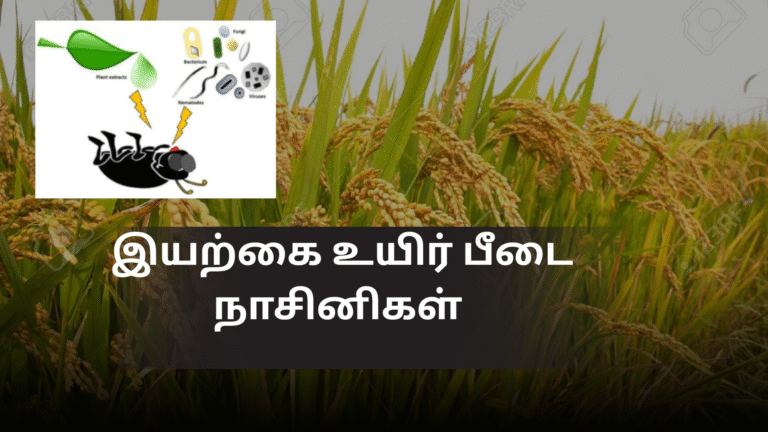இயற்கை உயிர் பீடை நாசினிகள்
🍃🍃🍃🍃🍃🍃🍃🍃🍃🍃🍃
பொதுவாக, இரசாயனப் பூச்சிக்கொல்லியைத் தெளிக்கும்போது, சூழலுக்குப் பாதிப்பு ஏற்படுவதுடன், விளைபொருளும் நஞ்சாகிறது. இரசாயனப் பூச்சிக்கொல்லிகளின் தாக்குதலைத் தொடர்ந்து எதிர்கொள்ளும் பூச்சிகள், அந்தப் பூச்சிக்கொல்லிகளுக்கு எதிரான ஆற்றலை வளர்த்துக்கொள்கின்றன. இதனால், வீரியமான பூச்சிக்கொல்லிகளைப் பயன்படுத்த வேண்டிய கட்டாயத்துக்கு விவசாயிகள் ஆளாகிறார்கள்.
இதற்கு எளிமையான உதாரணமாக 1985 களில் உற்பத்தி செய்யப்பட்ட பூச்சி கொல்லிகள் மற்றும் நுளம்புசுருள்களில் (கொசுவத்தி) உள்ள நஞ்சின் சதவிகிதத்துக்கும், தற்போது 2025 இல் உற்பத்தி செய்யப்படும் மேற்கூறிய பொருட்களில் உள்ள நஞ்சின் சதவீத அதிகரிப்பை நாம் ஒப்பிட்டுப் பார்க்கலாம்.
இந்த 40 வருடங்களில், பூச்சிகள், அண்ணளவாக 920 தலைமுறைகளை உருவாக்கி இருக்கும் (தீமை செய்யும் பூச்சிகளின் வாழ்க்கை வட்டம் பொதுவாக 2 வாரங்கள்). அவற்றின் ஒவ்வொரு தலைமுறையும் நஞ்சுக்கு அதிக எதிர்ப்புள்ள தமது அடுத்த தலைமுறைகளை உருவாகும்.
ஆனால் 40 வருடங்களில் மனிதர்கள் இரண்டு தலைமுறைகளையே உருவாக்கி இருப்பார்கள். நஞ்சின் சதவிகித அதிகரிப்பால் பாதிக்கப்படுவது நாமும் மற்றும் எமது குழந்தைகளுமேயன்றி உண்மையில் பூச்சிகள் அல்ல.
ஆயினும் நஞ்சு பூச்சி கொல்லிகளுக்கு அடிபணியாத நுளம்பு / கொசுக்கள், பல்லாண்டு காலமாக நாம் வேப்பிலை புகை இடும்போது விரட்டப்படுகிறது. இவ்வாறே இயற்கை விவசாயமும் நிலை பேறானது.
பயிர்களைத் தாக்கும் பூச்சிகளை அழிப்பதற்காக இயற்கை, சில இரை கவ்வி பூச்சிகளை மற்றும் நுண்ணுயிர்களை உருவாக்கியிருக்கிறது. இயற்கையின் இந்த ஏற்பாட்டை நாம் இன்னமும் முழுமையாகப் புரிந்து கொள்ளாமல், பயிர்களிலுள்ள பூச்சிகளை உடனடியாக அழிக்க வேண்டும் என்ற எண்ணத்தில், பரிந்துரைக்கப்பட்ட அளவையும் தாண்டி, பூச்சிக்கொல்லிகளைப் பயன்படுத்துகிறோம்.
சூழலுக்குக் பாதிப்பு வராமலும், விளைபொருள் விஷமாகாமலும் இருக்க மாற்று வழி இருக்கிறது. பயிர்களைப் பாதுகாத்து, தேர்வு முறையில் பூச்சிகளை அழிக்கும் சில நுண்ணுயிர்கள் இருக்கின்றன. இவற்றைப் பயன்படுத்திச் சூழலுக்குக் பாதிப்பு நேராமல் பூச்சிகளைக் கட்டுப்படுத்தலாம்.
இயற்கை விவசாயத்தைப் பொறுத்தவரை, பயிருக்கு நோய்த்தாக்குதலோ, பூச்சித்தாக்குதலோ இல்லாமல் பார்த்துக்கொள்வதுவதான் மிகவும் சவால் மிகுந்தது.
இந்த விஷயத்தில் நாம் கூடுதல் கவனம் செலுத்தாவிட்டால், பயிர்கள் நாசமாவதுடன், நம்உழைப்பையும், காசையும் வீணாக்கிவிடும். இதைத் தவிர்க்க என்ன செய்யலாம்
🍃திட்டமிடல் (Planning)
இயற்கை விவசாயத்தில் திட்டமிடல் என்பது மிக முக்கியமான ஒன்று . என்ன பயிர் செய்யப்போகிறோம். அது எத்தனை நாள் பயிர் (நாட்களை பொறுத்து பயோ பெஸ்டிசைடு தேவையான அளவு இருப்பு வைக்கலாம். பூச்சி நோய் எதிர்ப்பு ரகங்கள் இருக்கிறதா என்பதை உறுதி செய்து கொள்ள வேண்டும்.
அந்தப் பயிரில் எப்பொழுது பூச்சி , நோய் தாக்கும் தெரிந்து வைத்துக்கொள்ளுங்கள்.
தேவையான பயோ பெஸ்டிசைடு (Bio-Pesticide)எங்கே கிடைக்கும் என்பதைத் தெரிந்து வைத்துக்கொண்டு, குறைந்தது 6 மாத expiry உள்ள பயோ பெஸ்டிசைடு வாங்கி வைத்து கொள்ளலாம்.
🍃2 வகை (2 Types)
அத்தகைய பயோ-பெஸ்டிசைடு இரண்டு வகைப்படும்.
நுண்ணுயிரிகள் கொண்டுத் தயாரிக்கப்படுவது. அதாவது பாக்டீரியா போன்றவற்றை பயன்படுத்தி தயாரிக்கப்படுவது முதல்வகை.
பயோ கெமிக்கல் கொண்டு தயாரிக்கப்படுவது 2-வது வகை. அதாவது இயற்கையாக தாவரங்களில் உருவாகும் பொருளை கொண்டு தயாரிக்கப்படுவது. உதாரணமாக வேப்ப எண்ணெய் கரைசல் இந்த வகை இயற்கை பூச்சி விரட்டிகளை நாமே தயாரித்து கொள்ள முடியும்.
பயோ-பெஸ்டிசைடின் நன்மைகள் (Benefits of Bio-Pesticide)
செயற்கை விவசாயத்தை விட பயோ பெஸ்டிசைடு பயன்படுத்துவதால் விளைவுகள் மிக மிக குறைவாகத்தான் இருக்கும்.
பயோ பெஸ்டிசைடு தெளிப்பதால் நாம் எதன் மீது தெளிகிறோமோ அதன் மீதுதான் அதன் தாக்கம் இருக்கும்.
பூச்சி கொல்லிமாதிரி நிலம், பறவைகள் , நன்மை செய்யும் பூச்சிகள் மற்றும் விலங்குகள் பாதிக்கப்படாது.
உயிர் பூச்சி கொல்லிகள் குறைந்த அளவில் அதிகம் பலன் தரக்கூடியவை மற்றும் வேகமாகவும் மக்கிவிடும்.
1) வெர்டிசிலியம் லக்கானி ( Verticillium lecani)
அனைத்து வகையான சாறு உறிஞ்சும் பூச்சிகளையும் கட்டுப்படுத்தலாம். ( aphids, jassids, mealybugs, white flies, mites ) இது பூச்சிகளின் உடம்பிற்குள் நுழைந்து முடக்கி 5 முதல் 7 நாட்களுக்குள் அழித்துவிடும்.
2) பெவேரியா பேசியானா (Beauveria bassiana)
காய்துளைப்பானை மற்றும் thrips போன்றவற்றைக் கட்டுப்படுத்தக்கூடியது . இது பூச்சிகளின் செரிமானப்பகுதியை தாக்கி 5 முதல் 7 நாட்களுக்குள் அழித்துவிடும்.
3) பெசிலியோமைசிஸ் (Paecilomyces lilacinus)
இது எல்லா வகையான நெமடோட்களையும் (nematodes) கட்டுப்படுத்தக்கூடியது.
இது செரிமான பகுதியை தாக்கி முடக்கி அழித்துவிடும்.
4) ட்ரைகோடெர்மா விரிடி மற்றும் ஹாசனியம் (Trichoderma viride and Harzianum)
இது உயிர் பூஞ்சானக் கொல்லியாகும். மண் சார்ந்த வேர் அழுகல் நோயைக் கட்டுப்படுத்த கூடியது.
5) சூடோமோனஸ்
இதுவும் ஒரு பூஞ்சான கொல்லியாகும், பூஞ்சானக் கொல்லியாக மட்டுமல்லாமல் பயிர் வளர்ச்சி ஊக்கியாகவும் செயல்படும்.
6) பேசில்ஸ் துருஞ்சியன்சிஸ்
பெரிய வகை புழுக்களையும் கட்டுப்படுத்த வல்லது.
இந்த அனைத்து பயோ- பெஸ்டிசைடுகளும், இயற்கை விவசாயிகள் கட்டாயம் கையில் வைத்திருக்க வேண்டியது அவசியம். (மூலக்கட்டுரை நீர் மேலாண்மையும் பண்ணை மேம்பாடும் பக்கத்தில் இருந்து பெறப்பட்டது.)
மேலதிக விபரங்கள்
CSJ Agri
076 225 0017
மேலதிக தகவல்களுக்கு மாற்றம் செய்திகள் இணையத்தளத்தினுள் பிரவேசியுங்கள்.
மேலதிக தகவல்களை உடனுக்குடன் பெற்றுக்கொள்ள மாற்றம் செய்திகள் முகநூல் பக்கத்தை பின்தொடரவும்.
🌿 Natural Bio-Pesticides: The Eco-Friendly Way to Protect Crops
🍃🍃🍃🍃🍃🍃🍃🍃🍃🍃🍃
Generally, when chemical pesticides are sprayed on crops, they not only harm the environment but also make the produce toxic. Over time, the insects exposed to these chemicals develop resistance, forcing farmers to use stronger and more harmful pesticides.
For example, if we compare the chemical concentration in pesticides and mosquito coils manufactured in 1985 with those made in 2025, we can see a significant increase.
In these 40 years, pests have evolved through nearly 920 generations (as most harmful insects have a life cycle of about two weeks). Each new generation becomes more resistant to pesticides.
Humans, however, have produced only two generations in that same period — meaning, it’s we and our children who are more affected by increased toxicity, not the insects.
Interestingly, mosquitoes that have become immune to chemical sprays are still repelled by traditional neem smoke, showing the lasting effectiveness of natural methods. Similarly, organic farming remains sustainable and environmentally friendly.
Nature itself has created certain predatory insects and microorganisms to control crop pests. However, without understanding this natural balance, we tend to use chemical pesticides excessively, trying to kill every pest immediately.
There’s a better, eco-friendly solution — using bio-pesticides that protect crops while targeting only specific harmful pests, without poisoning the environment or the produce.
🌾 Importance of Pest and Disease Control in Organic Farming
In organic farming, one of the biggest challenges is preventing pest and disease attacks without the use of harmful chemicals.
If not managed carefully, these can destroy crops, wasting both effort and money.
So, how can this be avoided? Let’s look at some effective approaches 👇
🍃 Step 1: Proper Planning
Planning is extremely important in natural farming.
- Decide which crop you are going to cultivate and its duration.
- Based on the crop cycle, estimate how much bio-pesticide stock you will need.
- Choose disease- and pest-resistant crop varieties when possible.
- Identify the common pests and the time of year they usually attack that crop.
Also, find out where you can get reliable bio-pesticides and ensure that they have at least six months of shelf life before purchasing.
🍃 Step 2: Two Main Types of Bio-Pesticides
Bio-pesticides are broadly divided into two categories:
1️⃣ Microbial-based Bio-Pesticides – Made from microorganisms like bacteria, fungi, or viruses that attack specific pests.
2️⃣ Bio-Chemical-based Bio-Pesticides – Derived from natural plant extracts such as neem oil or other organic compounds. These are eco-friendly and can even be prepared at home using natural ingredients.
🌱 Benefits of Bio-Pesticides
- Bio-pesticides are much safer compared to chemical pesticides.
- They act only on targeted pests, not on beneficial insects, birds, or animals.
- They decompose quickly and leave no harmful residue in soil or crops.
- A small quantity is often enough to achieve effective pest control.
🐞 Common Types of Bio-Pesticides and Their Uses
1️⃣ Verticillium lecanii
- Controls all types of sap-sucking insects such as aphids, jassids, mealybugs, whiteflies, and mites.
- It enters the insect’s body, paralyzes it, and kills it within 5–7 days.
2️⃣ Beauveria bassiana
- Effective against fruit borers and thrips.
- Attacks the insect’s digestive system and destroys it within 5–7 days.
3️⃣ Paecilomyces lilacinus
- Controls nematodes that damage plant roots.
- Affects their digestive system, paralyzing and killing them.
4️⃣ Trichoderma viride and Trichoderma harzianum
- Act as bio-fungicides that prevent soil-borne fungal diseases like root rot.
5️⃣ Pseudomonas fluorescens
- Another bio-fungicide that not only fights fungal infections but also stimulates plant growth.
6️⃣ Bacillus thuringiensis (Bt)
- Very effective against large caterpillars and larvae.
🌿 Conclusion
Every organic farmer should keep these bio-pesticides readily available, as they are essential for natural pest management.
They protect the crops, maintain ecological balance, and ensure the produce remains healthy and toxin-free for consumption.
(Source: Article adapted from “Water Management and Farm Development” publication)
📞 For more information:
CSJ Agri
📱 076 225 0017



